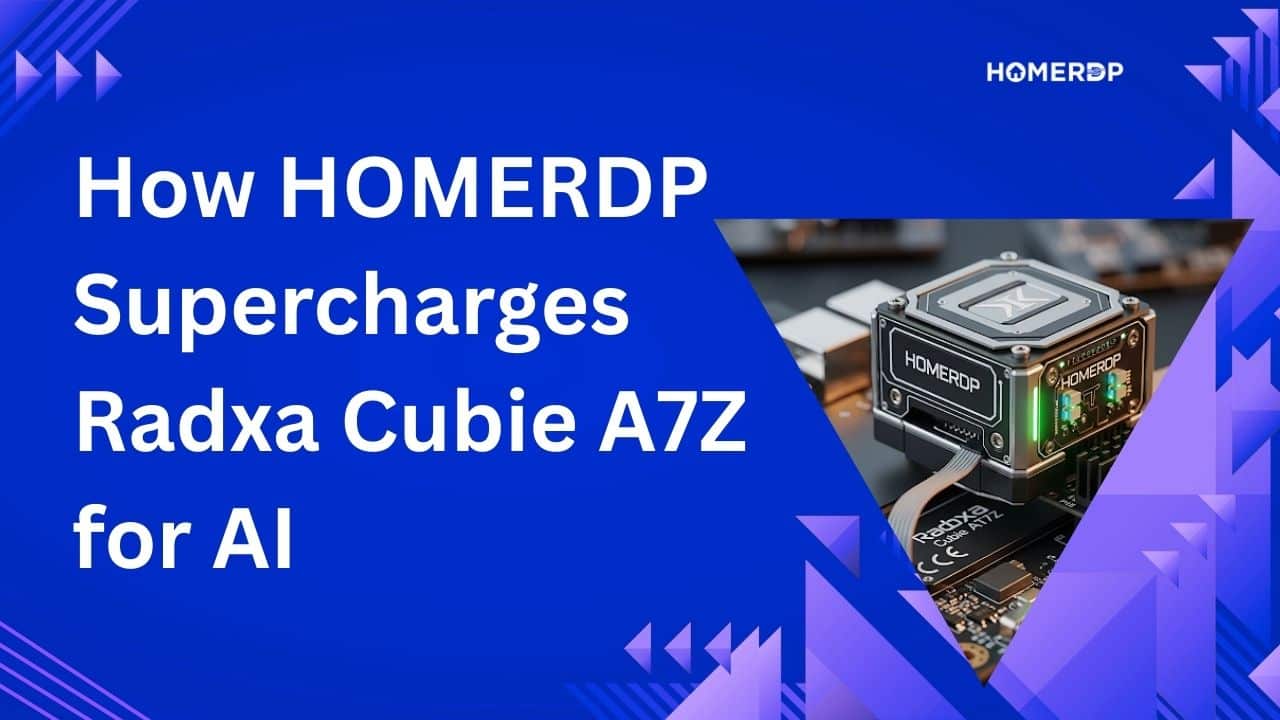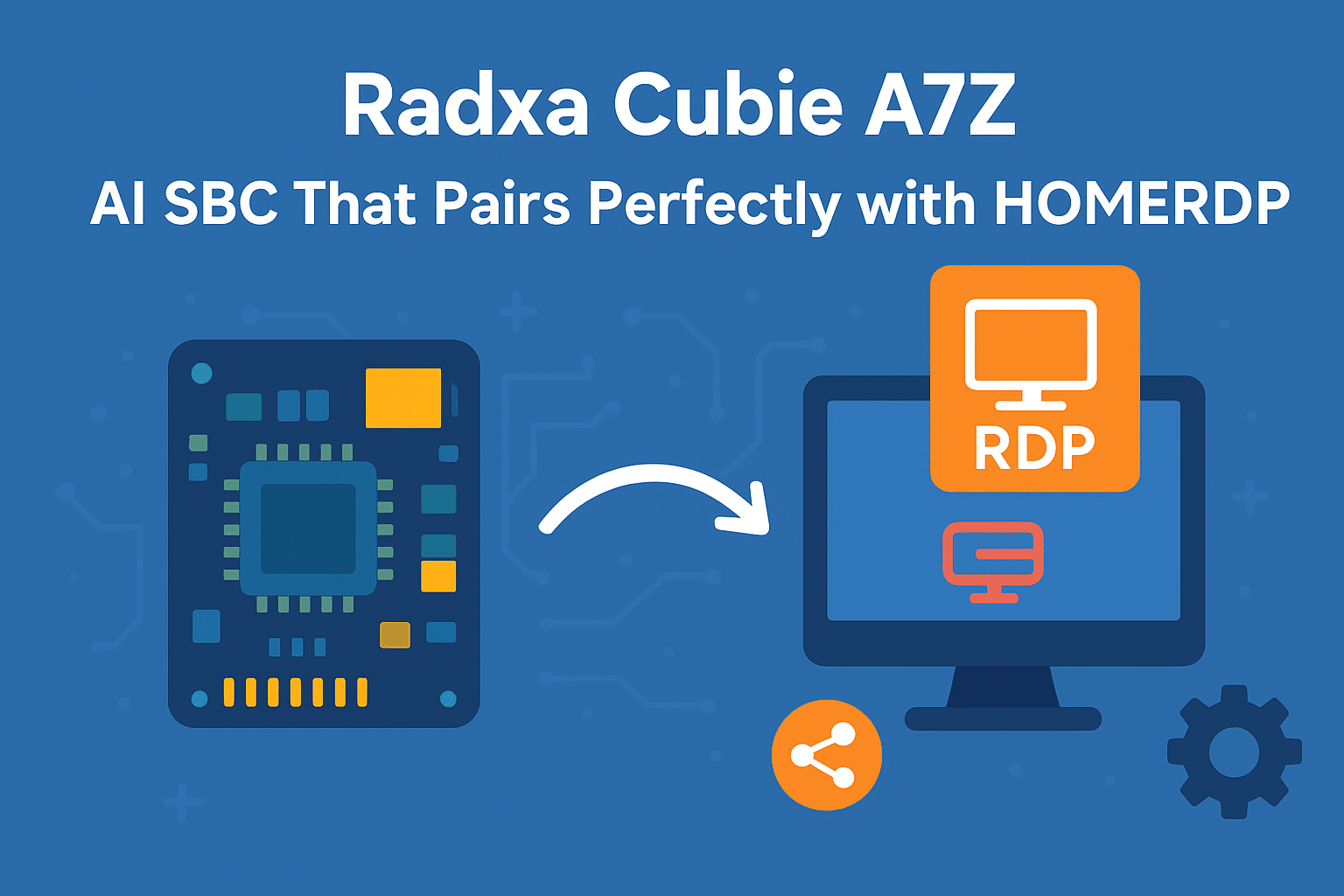Radxa Cubie A7Z: The Ultra-Compact AI SBC That Pairs Perfectly with HOMERDP

The world of single-board computers (SBCs) continues to evolve rapidly, balancing affordability with raw performance. While the Raspberry Pi series often dominates headlines, innovative alternatives are emerging to fill critical gaps in compute density, AI capability, and scalability. One such competitor is the Radxa Cubie A7Z—a Raspberry Pi Zero–sized powerhouse that offers an incredible mix of CPU, GPU, and AI acceleration in a board just 65 × 30 mm in size.
But here’s the real advantage: when developers and enterprises combine this compact SBC with HOMERDP’s high-performance remote desktop services, they unlock universal access, better productivity, and flexible scaling. This combination bridges the gap between local edge computing and remote infrastructure, empowering teams to test, deploy, and maintain AI workloads seamlessly.
1. A Closer Look at the Radxa Cubie A7Z
The Radxa Cubie A7Z packs a surprising amount of power into its tiny frame. At first glance, its size resembles the Raspberry Pi Zero, but its hardware takes performance several notches higher.
- CPU & GPU Powerhouse:
At its core lies the Allwinner A733 SoC, featuring 2× Cortex-A76 cores clocked up to 2.0 GHz and 6× Cortex-A55 efficiency cores running at up to 1.8 GHz. Graphics tasks are handled by an Imagination BXM-4-64 MC1 GPU, capable of 4K rendering. - Built-in AI Acceleration:
The A7Z is equipped with a 3 TOPS Neural Processing Unit (NPU)—a rare feature in this size category. For edge AI tasks such as computer vision, speech recognition, and robotics, this makes the board a cost-efficient yet capable solution. - Memory and Storage Flexibility:
Configurations range from 1 GB to 16 GB LPDDR4/4x RAM, with options for UFS 3.0 storage up to 512 GB. Users can also expand via microSD, giving plenty of room for lightweight OS setups or data-intensive applications. - Connectivity Options:
- Wireless: Wi-Fi 6 + Bluetooth 5.3/5.4 ensures modern wireless connectivity.
- Display: Micro HDMI supports 4K60 output, while USB-C supports DisplayPort Alt Mode.
- Expansion: PCIe Gen3 via FPC, MIPI CSI camera interfaces, and a 40-pin GPIO header expand its potential into robotics, sensors, and prototyping.
- Affordable Pricing:
Perhaps the biggest headline is its price: starting at just $15 for the 1 GB variant, with higher-tier versions scaling with RAM.
This balance of affordability, AI power, and compact form factor makes the Cubie A7Z an appealing choice for students, hobbyists, researchers, and industry developers alike.
2. Why the Cubie A7Z Matters
The SBC market is saturated, but the Cubie A7Z offers value in ways that set it apart:
- Edge AI Made Accessible: Its 3 TOPS NPU provides an entry point for AI development without needing a large GPU server.
- Compact Power: At 65 × 30 mm, the board delivers processing capabilities that once required much larger setups.
- Affordable Scaling: Starting at just $15, organizations can deploy multiple boards in parallel for distributed AI testing or IoT networks.
- Flexible Applications: From robotics and smart cameras to IoT gateways and embedded systems, its versatile interface makes it adaptable across industries.
This makes it not just a “smaller Pi,” but a purpose-built, AI-ready alternative for workloads where both size and intelligence matter.
3. Where HOMERDP Complements the Cubie A7Z
While the Cubie A7Z shines in size and compute efficiency, real-world projects often demand remote accessibility, secure management, and scalability. This is where HOMERDP’s services enter the picture.
HOMERDP provides affordable, high-performance RDP servers with full administrator access, hosted across multiple regions including the USA, UK, Netherlands, and India. Pairing this infrastructure with Cubie A7Z boards solves three major challenges:
- Remote Access & Control
- Developers can connect to Cubie-powered labs or devices remotely using HOMERDP.
- This eliminates the need to physically handle boards for every update or experiment.
- Seamless Development Environments
- HOMERDP desktops can run Linux distributions, SDKs, AI frameworks, and debugging tools, while interfacing with Cubie boards at the edge.
- The result: you develop in a full desktop environment while managing compact edge devices remotely.
- Scalable Edge Management
- Organizations deploying fleets of Cubie A7Z devices can centralize control through HOMERDP servers.
- Updates, monitoring, and performance analysis become centralized, efficient, and secure.
By bridging edge hardware with remote infrastructure, HOMERDP allows teams to focus on innovation instead of logistics.

4. Strategic Use Cases: Cubie A7Z + HOMERDP
This combination unlocks several exciting real-world workflows:
- Remote AI Development Hub
- Deploy a cluster of Cubie A7Z boards in a lab.
- Access and manage them through HOMERDP desktops, installing new models, debugging, and benchmarking AI performance.
- Distributed Robotics & IoT
- Robotics projects often span across test sites. Cubie boards power the devices, while HOMERDP gives developers secure, centralized access to monitor and tweak algorithms.
- Edge Deployment with Remote Maintenance
- Place Cubie boards in remote offices or IoT environments.
- Use HOMERDP to push updates, reconfigure memory usage, or analyze logs without physical intervention.
- Hybrid Cloud + Edge Prototyping
- Run AI training workflows in the cloud, but deploy lighter inference models on Cubie devices.
- HOMERDP provides the “bridge layer” for testing, optimizing, and scaling these deployments.
5. Data-Driven Perspective
- Flat growth in traditional SBCs: Raspberry Pi availability and cost fluctuations have left developers searching for reliable alternatives. Radxa’s Cubie A7Z fills this space with a consistent supply chain and affordable entry pricing.
- AI at the edge demand: The global edge AI hardware market is projected to grow at 21.5% CAGR through 2030, with compact NPUs like the Cubie A7Z’s becoming critical.
- Remote access adoption: Post-pandemic, 75% of development teams rely on remote desktops or cloud-based labs to collaborate and maintain hardware efficiently. HOMERDP aligns perfectly with this trend, offering high-uptime infrastructure with 99.99% availability.
This data underscores why pairing affordable edge AI hardware with scalable remote desktops creates a winning formula.
Conclusion
The Radxa Cubie A7Z is more than just another SBC. By condensing AI-ready power into a Pi Zero-sized form factor, it democratizes access to edge intelligence at a starting price of just $15.
However, real innovation happens when this hardware is combined with HOMERDP’s robust remote desktop services. Together, they allow developers, researchers, and enterprises to manage edge devices at scale—securely, efficiently, and globally.
👉 Whether you are experimenting with AI, building robotics prototypes, or deploying IoT networks, pair the Cubie A7Z with HOMERDP to accelerate your workflows and unlock next-level productivity.
EXPLORE MORE; Banana Pi Strikes Again!Next-Gen SBC: Perfect for IoT, AI, and Edge Computing
READ OUR BLOGS

